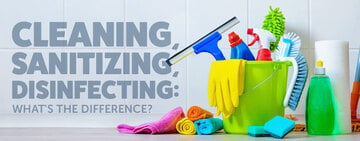How to Clean a Soda Gun
Last updated on May 9, 2025Michale LeRoyWhen it's time to close down the bar and start your cleaning checklist, there's one piece of equipment that is sometimes neglected. Your soda gun, also called a bar gun or post-mix dispenser, gets a lot of use during a busy shift. The residue left behind from dispensing sodas and mixers can cause a sticky buildup, so it's important to establish a cleaning routine for this useful dispenser. Follow our step-by-step instructions for keeping your soda gun sparkling clean.
Cleaning a Bar Gun
Watch our step-by-step video to learn how to clean your bar gun:
How to Clean a Soda Gun the Right Way
A dirty soda gun can lead to mold, bacteria, and yeast buildup, which can contaminate your drinks and affect their taste. Regular cleaning also helps prevent clogs and blockages that can disrupt the flow of soda and cause dispensing issues. A clean soda gun is just as important as spotless barware and pristine tap lines when it comes to the overall cleanliness of your bar. To properly clean a bar soda gun, you will need a few supplies and follow a simple step-by-step process.
Supplies Needed:
- Sanitizing Solution: Your product manual will recommend an approved sanitizer, but in general, a 100 PPM chlorine solution is appropriate. Do not use bleach because it is too corrosive.
- Sanitizing Pail: Mix your solution in a designated sanitizing pail.
- Cleaning Brushes: Use a small cleaning brush for scrubbing the crevices.
- Clean Cloth or Towel: Use a clean cloth or towel to wipe down the exterior of the soda gun and any spills.
- Rubber Gloves and Safety Googles: Protect your eyes and skin from the sanitizer by using the right PPE. We recommend dishwashing gloves and protective goggles.
Cleaning Process for Soda Gun

- Turn off the Soda Gun: Before starting the cleaning process, make sure to turn off the soda gun to prevent any accidental dispensing of soda.
- Prepare the Sanitizing Solution: Prepare the sanitizing solution to 100 PPM. This is a low dilution that won't damage the parts of the gun when used per our directions.
- Clean the Sheathing: The sheathing is the long metal cord that connects the soda gun to your bar. Use a cleaning brush dipped in sanitizer to clean the whole length of the sheathing. It's recommended to run the brush up and down the sheathing several times before drying it off with a clean bar towel.
- Clean the Holster: Don't forget to wipe down the holster where the soda gun sits. This area is prone to collecting drips of soda throughout the shift.
- Remove Nozzles and Diffusers: Carefully remove the nozzles and diffusers from the soda gun. Soak these components in the sanitizer for two minutes. While still submerged, use a cleaning brush to scrub them clean. Remove the nozzle and diffuser from the solution and place on a clean towel to air dry.
- Clean the Soda Gun Body: Use a clean cloth or towel dampened with the sanitizer solution to wipe down the exterior of the soda gun. Pay attention to any spills or sticky residue.
- Reassemble the Soda Gun: Once all components are clean and dry, reassemble the soda gun by attaching the nozzles and diffusers back in place.
- Test the Soda Gun: Turn the soda gun back on and test it to ensure that it is dispensing soda properly and there are no leaks or issues.
Soda Gun FAQ

We answer common soda gun cleaning questions below:
How Often Should I Clean My Soda Gun?
Daily cleaning should be done to remove any visible dirt or buildup on the exterior of the gun and the nozzles. A deep clean should be performed once a week. This involves disassembling the gun, soaking the parts in a cleaning solution, scrubbing away any residue, and thoroughly rinsing and sanitizing all components.
What Should I Do If the Nozzle Sticks?
If you're having trouble removing the nozzle from the gun for cleaning, try this method. Soak the nozzle of the gun in a glass of carbonated soda water for five minutes. This should loosen the sticky residue so you can remove the nozzle.
Is It Ok to Soak Soda Gun Parts Overnight?
It's not recommended to soak your soda gun parts overnight. This has the potential to wear down components like o-rings and lead to more frequent replacements.
Can I Submerge the Handle of the Gun for Cleaning?
If you're having trouble cleaning stubborn residue from between the buttons on the gun handle, you can soak the handle in cold or lukewarm water for two to five minutes. Do not soak the handle in sanitizer or hot water because it could damage the buttons and internal components. After soaking in water, use a cleaning brush dipped in sanitizer to remove the loosened buildup.
By establishing a regular cleaning schedule, you can ensure that your soda gun operates efficiently, your beverages taste fresh, and you maintain a hygienic environment for your customers. Prioritizing cleanliness not only enhances the overall customer experience but also prolongs the lifespan of your soda gun equipment.



